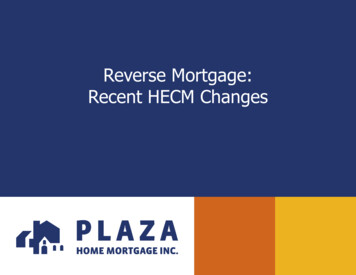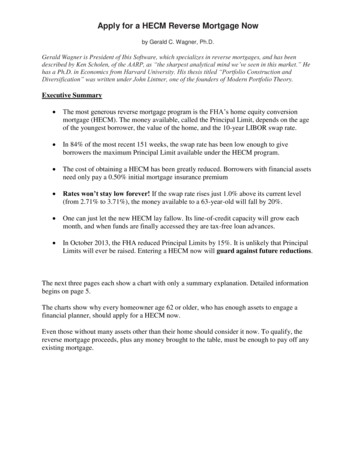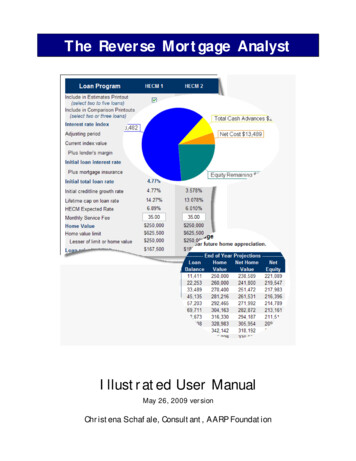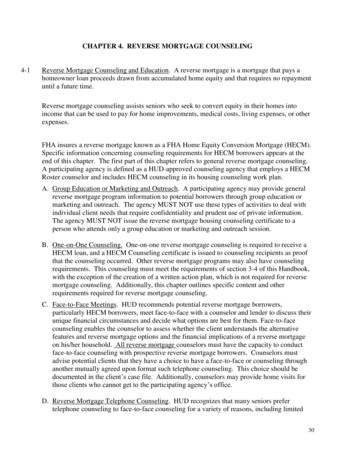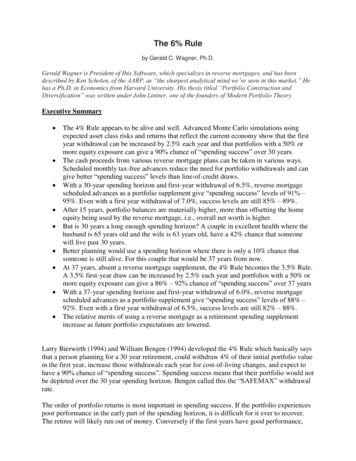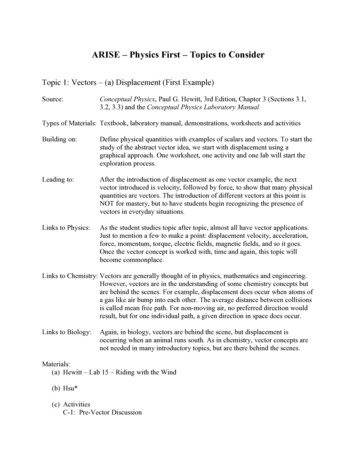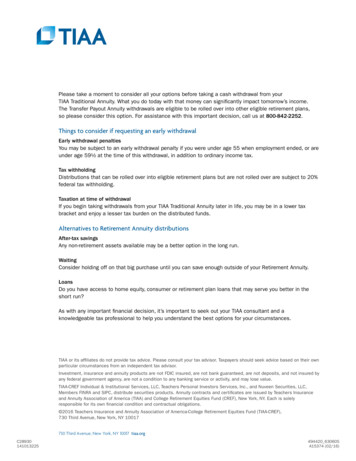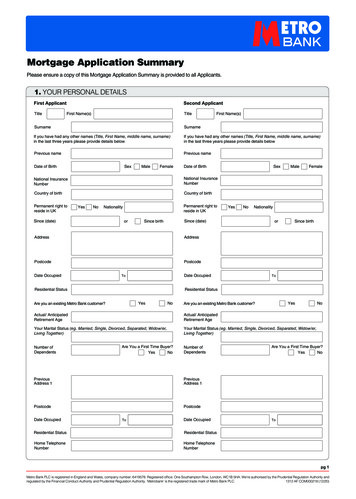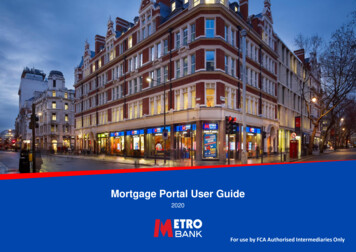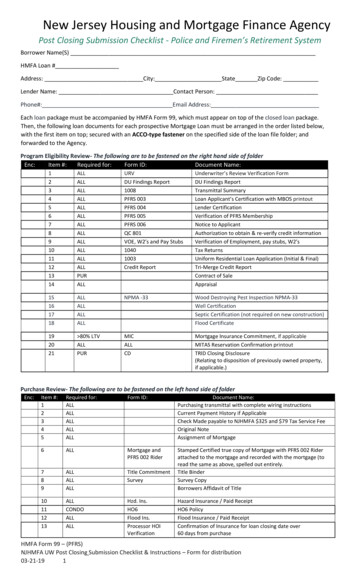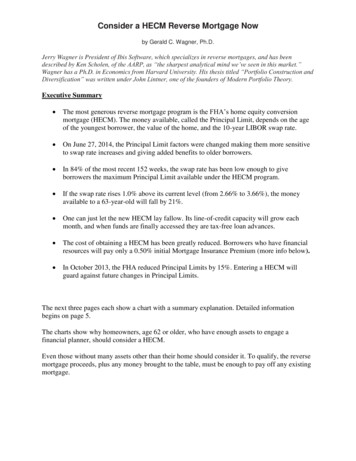
Transcription
Consider a HECM Reverse Mortgage Nowby Gerald C. Wagner, Ph.D.Jerry Wagner is President of Ibis Software, which specializes in reverse mortgages, and has beendescribed by Ken Scholen, of the AARP, as “the sharpest analytical mind we’ve seen in this market.”Wagner has a Ph.D. in Economics from Harvard University. His thesis titled “Portfolio Construction andDiversification” was written under John Lintner, one of the founders of Modern Portfolio Theory.Executive SummaryThe most generous reverse mortgage program is the FHA’s home equity conversionmortgage (HECM). The money available, called the Principal Limit, depends on the ageof the youngest borrower, the value of the home, and the 10-year LIBOR swap rate.On June 27, 2014, the Principal Limit factors were changed making them more sensitiveto swap rate increases and giving added benefits to older borrowers.In 84% of the most recent 152 weeks, the swap rate has been low enough to giveborrowers the maximum Principal Limit available under the HECM program.If the swap rate rises 1.0% above its current level (from 2.66% to 3.66%), the moneyavailable to a 63-year-old will fall by 21%.One can just let the new HECM lay fallow. Its line-of-credit capacity will grow eachmonth, and when funds are finally accessed they are tax-free loan advances.The cost of obtaining a HECM has been greatly reduced. Borrowers who have financialresources will pay only a 0.50% initial Mortgage Insurance Premium (more info below).In October 2013, the FHA reduced Principal Limits by 15%. Entering a HECM willguard against future changes in Principal Limits.The next three pages each show a chart with a summary explanation. Detailed informationbegins on page 5.The charts show why homeowners, age 62 or older, who have enough assets to engage afinancial planner, should consider a HECM.Even those without many assets other than their home should consider it. To qualify, the reversemortgage proceeds, plus any money brought to the table, must be enough to pay off any existingmortgage.
Consider a HECM Reverse Mortgage NowPage 2Chart 1 shows the history of the LIBOR rates used with a HECM. It starts on July 10, 2000,which was the first week that the Fed published the 10-year swap rate. The latest rates shown arefor the week of June 30, 2014.Until the last few years, rates have been volatile. The Fed has been keeping rates artificially low,but they are now talking about backing off of that policy.Chart 1LIBOR History8.0%7.0%10-Year Swap Rate1-Year LIBOR6.0%1-Month LIBOR5.0%4.0%3.0%2.0%1-month LIBORspikes to 4.59%then falls to 0.36%in 14 2005200420032002200120001999
Consider a HECM Reverse Mortgage NowPage 3Chart 2 shows the Principal Limits available to a 63-year-old borrower that owns a 300,000home. The calculations are for a monthly adjusting HECM with a 2.25% lender margin.Borrowers have enjoyed the maximum benefit in many weeks over the last three years. Thevalues in the chart use the June 2014 Principal Limit factors.Chart 2 - HECM Principal LimitsAssuming a 63-year Old in a 300,000 Home with a 2.25% Margin 170,000 145,000 120,000Maximum HECMPrincipal Limit 95,000 70,000 20032002200120001999
Consider a HECM Reverse Mortgage NowPage 4Chart 3 shows how borrowers of different ages will be affected by rising rates. If the 10-yearswap rate goes up to its historic averages, benefits will be materially reduced. Chart 3 plotsfigures from Table 1 in the Appendix. The figures use the June 2014 Principal Limit factors.Chart 3 - HECM Principal LimitsAssuming a 300,000 home and a 2.25 margin 225,00083-year old 200,00073-year old 175,00063-year old 150,000 125,000 100,000Week ofJune 30, 2014 75,000Average over thelast 13 years 50,000 25,000 02.50%3.00%3.50%4.00%4.50%Average over2000 - 20115.00%5.50%10-year LIBOR Swap Rate6.00%6.50%7.00%7.50%
Consider a HECM Reverse Mortgage NowPage 5Mortgage Insurance PremiumsThe primary reverse mortgage program available today is the FHA’s HECM. It comes with twolevels of FHA initial Mortgage Insurance Premium (MIP). If draws in the first year will exceed60% of the total funds available, the initial MIP is 2.50%. If draws in the first year are 60% orless, the initial MIP is only 0.50%. MIP is based on the home value (capped at the FHA lendinglimit, currently 625,500). On a 300,000 home, the MIP would be either 7,500 (2.50%) or 1,500 (0.50%). It is worthwhile to pay down existing liens to move below the 60% first-yeardraw threshold. That would eliminate 6,000 in MIP. After one year has passed, you can drawany pay downs back out of the HECM without incurring extra MIP.Besides this initial MIP, a HECM accrues ongoing MIP at an annual rate of 1.25% of theoutstanding loan balance. Imagine the initial MIP and the ongoing MIP going into a FHA reservepool that allows a HECM to be a nonrecourse loan. This means that the borrower or their heirswill never owe more than the home is worth. Subject to certain FHA rules, the heirs can buy thehome for 95% of its then current appraised value. For example, if in 15 years, the home is worth 400,000 and the HECM balance is 500,000, the heirs can buy the home for 380,000, and theFHA reserve pool would absorb the 120,000 shortfall.HECM Interest RatesThere are two rates to consider: the Expected Rate and the Effective Rate. The Expected Rate isset at closing and never changes. It is the 10-year LIBOR swap rate plus the lender’s margin.Throughout these notes, we assume that the lender’s margin is 2.25%. HECM has a 120-day ratelock feature such that the swap rate used is the better of the one at application or at closing. Soby applying for a HECM under present conditions, the maximum proceeds can be enjoyed evenif rates rise materially over the 60 days it may take to close the loan. The Expected Rate is fixedfor the life of the loan and is used for any future payment plan change calculations.The HECM Principal Limit factor is found in a lookup table using the youngest borrower’s ageand the Expected Rate rounded to the nearest one-eighth percent subject to a lookup floor of 5%.As rounded Expected Rates increase, such as from 5.125% to 5.250%, Principal Limits fall.Because of the 5% floor, any Expected Rate of 5.06% or less gives the maximum PrincipalLimit. 5.06% rounds down to 5.00%, but 5.07% rounds up to 5.125% resulting in less moneybeing available.The Effective Rate is the chosen index plus the lender’s margin (2.25% in this example) plusongoing MIP (1.25%). There are two forms of adjusting rate LIBOR HECM’s -- one adjustsmonthly and the other adjusts annually. The index for the monthly adjusting HECM is the onemonth LIBOR rate as published five weeks before the rate change. This allows loan servicers tonotify borrowers in their monthly statements what the new rate will be. The monthly adjustingHECM generally has a lifetime cap increase of 10% above the initial rate. Historically thechances of reaching this cap are very low. Recently some lenders have been offering a monthlyadjusting HECM with a 5% lifetime cap increase.The annually adjusting HECM uses the one-year LIBOR rate as its index. It generally has a 2%cap on annual changes and a 5% lifetime cap. Lenders often charge a higher margin on annuallyadjusting HECM’s than they do on monthly adjusting HECM’s.
Consider a HECM Reverse Mortgage NowPage 6The initial Principal Limit grows each month at the Effective Rate divided by 12. At any point inthe future, the line-of-credit capacity is the future Principal Limit less the then current loanbalance less the future service fee set-aside, if any. This is a good feature. A monthly adjustingHECM’s line-of-credit could grow at an annual rate of 3.65%; that’s the 0.152% 1-monthLIBOR index, plus the 2.25% lender’s margin, plus 1.25% ongoing MIP. And, with a 1-yearLIBOR index of 0.545%, an annually adjusting HECM line could grow at 4.05%. These growthrates are tax-free.This means that a borrower with financial resources could pay down their HECM rather than puttheir money into a taxable, low yield CD. The HECM line-of-credit would grow tax-free untilfunds are needed. Withdrawals are considered loan advances and are tax-free. Unlike atraditional HELOC, a HECM line-of-credit cannot be reduced so long as the borrower meets theloan terms. Terms include that the home remain the principal residence and that property taxesand homeowner insurance premiums are timely paid.Why consider a HECM now?With a 2.25% lender margin, the highest 10-year swap rate that will give the maximum HECMbenefits is 2.81%. Lower margins are available from some lenders, but even with a 2.00%margin, the highest 10-year swap rate could be 3.06% to give the maximum. The index and themargin must add up to 5.06% or less to give the maximum Principal Limit. In the week of June30, 2014, the swap rate was 2.66%. This is not much leeway from 2.82%, where Principal Limitswould fall a notch. When you apply for a HECM, there is a rate lock that is good for 120 days.The two tables in the Appendix show how Principal Limits are affected by rising rates.Copyright 2014 Gerald C. Wagner. All rights reserved.Here is a Bibliography of recent articles showing how a reverse mortgage can be a valuableretirement tool even for borrowers that have material resources. You can read my article and usethe calculators at aspBibliographyPfeiffer, Shaun, C. Angus Schaal, and John Salter. 2014. “HECM Reverse Mortgages: Now orLast Resort?” Journal of Financial Planning 27 (5) 44–51.Pfeiffer, Shaun, John Salter, and Harold Evensky. 2013. “Increasing the Sustainable WithdrawalRate Using the Standby Reverse Mortgage” Journal of Financial Planning 26 (12): 55-62.Sacks, Barry H. and Stephen R. Sacks. 2012. “Reversing the Conventional Wisdom: UsingHome Equity to Supplement Retirement Income” Journal of Financial Planning 25 (2): 43-52.Salter, John, Shaun Pfeiffer, and Harold Evensky. 2012. “Standby Reverse Mortgages: A RiskManagement Tool for Retirement Distributions” Journal of Financial Planning 25 (8): 40-48.Wagner, Gerald C. 2013. “The 6.0 Percent Rule” Journal of Financial Planning 26 (12): 46-54.
Consider a HECM Reverse Mortgage NowPage 7Appendix Table 1 - Principal Limits Given Lookup RatesAssuming a 300,000 home with a 2.25% margin10-YearSwap 0%9.125%9.250%9.375%9.500%9.625%Age63 159,000 154,200 149,400 144,600 139,800 134,700 129,900 125,100 120,300 117,300 114,000 111,000 108,000 104,700 101,700 98,700 95,400 92,700 90,000 87,000 84,300 81,300 78,600 75,900 72,900 70,800 68,700 66,300 64,200 62,100 59,700 57,600 55,200 53,400 51,600 49,800 48,000 46,200Age68 168,600 164,100 159,300 154,500 149,700 144,900 140,400 135,600 130,800 127,500 124,500 121,200 118,200 114,900 111,900 108,600 105,300 102,600 99,900 97,200 94,500 91,800 89,100 86,400 83,400 81,300 78,900 76,500 74,100 72,000 69,600 67,200 64,800 63,000 61,200 59,400 57,300 55,500Age73 179,700 174,900 170,400 165,600 161,100 156,600 151,800 147,300 142,500 139,500 136,200 133,200 130,200 126,900 123,900 120,600 117,600 114,900 111,900 109,200 106,500 103,800 101,100 98,100 95,400 93,000 90,900 88,500 86,100 83,700 81,300 79,200 76,800 74,700 72,600 70,800 68,700 66,900Age78 192,000 187,500 183,000 178,500 174,000 169,500 165,000 160,500 156,000 153,000 149,700 146,700 143,700 140,700 137,400 134,400 131,400 128,700 126,000 123,300 120,600 118,200 115,500 112,800 110,100 107,700 105,300 102,900 100,500 98,100 95,700 93,300 90,900 89,100 87,000 84,900 82,800 80,700Age83 204,600 200,400 196,200 192,000 187,500 183,300 179,100 174,900 170,700 167,700 164,700 162,000 159,000 156,000 153,000 150,000 147,300 144,600 141,900 139,500 136,800 134,400 131,700 129,300 126,600 124,200 121,800 119,400 117,300 114,900 112,500 110,100 107,700 105,600 103,500 101,400 99,600 97,500Age88 218,700 214,800 210,900 207,000 203,100 199,200 195,300 191,400 187,500 184,500 181,800 179,100 176,400 173,700 171,000 168,300 165,600 163,200 160,800 158,400 155,700 153,300 150,900 148,500 146,100 143,700 141,300 139,200 136,800 134,400 132,000 129,600 127,500 125,400 123,300 121,200 119,100 117,000
Consider a HECM Reverse Mortgage NowPage 8Appendix Table 2 – Percentage Decline in Principal Limits as Rates RiseAssuming a new monthly-adjusting HECM with a 2.25% margin10-YearSwap -37%-39%-40%-41%-42%-43%-44%-45%-46%-47%
Consider a HECM Reverse Mortgage Now by Gerald C. Wagner, Ph.D. Jerry Wagner is President of Ibis Software, which specializes in reverse mortgages, and has been described by Ken Scholen, of the AARP, as “the sharpest analytical mind we’ve seen in this market.” Wagner has a Ph.D. in
